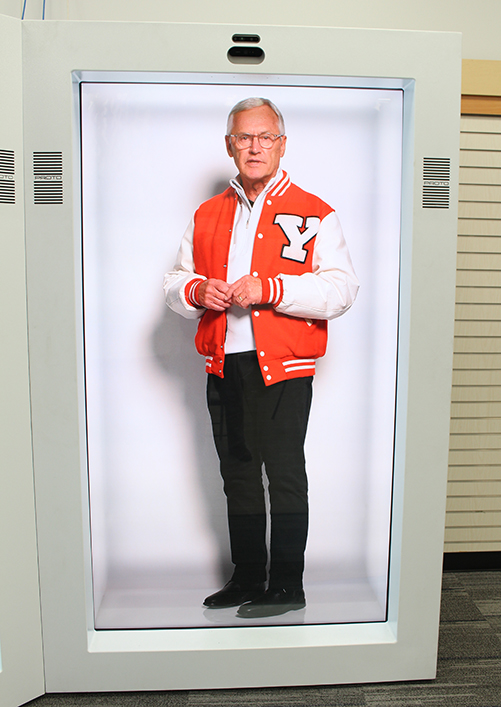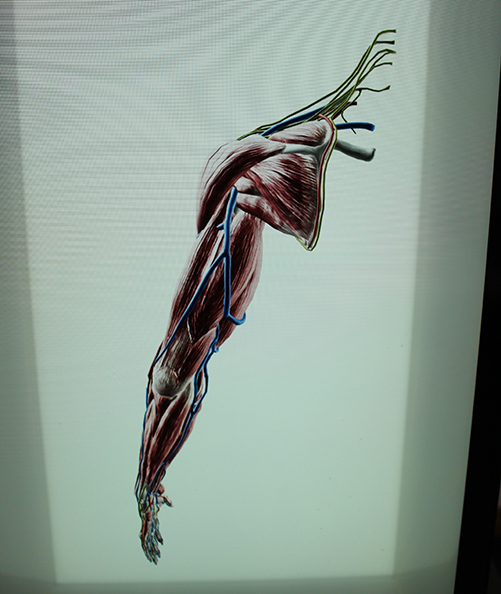BOARDMAN – It’s as close to a scene from the TV series “Star Trek” as one can get.
A device that stands approximately 7 feet high and a few feet deep glows in a white light through a clear, clean screen. Then, with the touch of a button, an image materializes out of thin air, projecting a life-size, lifelike, three-dimensional replica of a person who could be located halfway around the world but has been instantly beamed into your office, conference room or even your household.
This technology – once relegated to science fiction – will now be introduced to the Mahoning Valley and the Midwest through a new Boardman company, Futuristx, as it prepares to launch distribution of the Proto Hologram, a series of holographic devices developed by California-based Proto Inc.
“We are distributors focused on the Midwest,” says Jeff Hedrich, a partner and “futurist” for Futuristx, a company that occupies the storefront of Humtown Additive’s new 3D printing operation at 8301 Market St. “People really are driven by visual information. Seeing is believing,” he says.

Futuristx was born after Hedrich witnessed a demonstration of Proto’s holographic devices in Columbus 18 months ago. Hedrich, the president of Prodigal Media, a Boardman marketing and advertising firm, was intrigued about how artificial intelligence would shape the future of business.
“When I saw the Proto Hologram at a trade show in Columbus, I thought that AI can’t replace this, but it could enhance this.”
He then reached out to Mark Lamoncha, CEO of Humtown, who has successfully integrated additive manufacturing and 3D technology into his company’s sand core manufacturing business. The pair traveled to Los Angeles to explore the technology further and was approached about becoming a distributor. “A lot of thought went into this,” he says. “Anytime you’re working with new technology it takes some time and there’s some risk involved, but now we’re ready to launch.”
Futuristx – so named because Hedrich fashions the business as a “company of futurists” with “x” as an unknown variable – will be the local presence of Proto’s hologram devices. Initially, the company will sell three types: the “Epic” – the largest of the devices – a slightly smaller “Luma” model, and a desktop version called the “M.”
MANY POSSIBILITIES
Hedrich says the technology could be applied across many different industries, including manufacturing, the automobile market, education, and the medical field. “The technology has matured. We understand it very well,” he says.
Proto Hologram devices could be used by companies at trade shows to display new products, for example, or use its “live beam” feature to project the full, 3D image of an individual in real time who is able to interact with an audience or others in the room, since a camera at the top of the device allows for a return feed to encourage a two-way conversation. “There are multiple-use cases,” Hedrich says.
Lamoncha says he was first introduced to holograms several years ago at Disney, but the technology was imperfect. After being introduced to the latest holograms from Proto, he was convinced that the technology had advanced to a point where it made sense.
It was during a trade show in Cleveland where Lamoncha first had a chance to demonstrate the technology to a wider audience. “The opportunity existed to ask [comedian and game show host] Howie Mandel to come to the Huntington Center,” he recalls. “And that he did, via live beam.” The image was so life-like that many believed that Mandel was standing inside the device. “We were kind of apprehensive of what would happen at the show,” Lamoncha says. “The experience was better than we hoped for.”
Mandel is an investor in Proto, as is William Shatner, the actor who portrayed Capt. James T. Kirk in the 1960s television series “Star Trek.” That show featured futuristic technology that enabled officers of the starship Enterprise to teleport to and from nearby planets.

Lamoncha says Futuristx directly connects with “Industry 4.0,” the integration of technology into manufacturing. “We’re very excited about educational integration, community integration, and this type of technology allows us to do that in a much deeper level.”
As an example, Lamoncha displays a 3D image of its sand cores on one of the three Epic devices at the new showroom. By using a touch screen, the user can manipulate the image by separating its parts or rotating the product. “This is only the beginning,” he says.
Lamoncha says the technology’s main attribute is enhancing personal connections. Physicians, for example, can use a smaller unit to project animated diagrams of arm or shoulder tendons to better illustrate a patient’s condition. “Hip doctors or joint doctors can actually show a patient and display the procedure they’re going to do,” he says.
Auto dealers are also able to load 3D images of the latest vehicle models with detailed precision, he says.
PROTO HALL OF FAME
Futuristx’s new space, which Lamoncha dubs the “Proto Hall of Fame,” allows those in the region to experience the technology firsthand.
Moreover, the technology enables communication in more than 70 languages, thanks to enhancements from AI. In one case, the Luma device records and projects an image of a reporter introducing himself. At the touch of a button, the life-size image is replayed, only now the reporter is repeating the introduction in Mandarin Chinese in his own voice and correct mouth movements.
Hedrich says it’s unclear at the moment how the public will respond to this new technology – the Epic retails at approximately $30,000 and the smaller M sells for approximately $7,000.
“It’s about bringing innovative technologies to the visual economy,” Hedrich says.
“Visuals are becoming the primary means of communication. We’re bringing those technologies starting with the Proto Hologram,” he says.
Pictured at top: Jeff Hedrich and Mark Lamoncha are partners in a company that distributes Proto Hologram devices.
